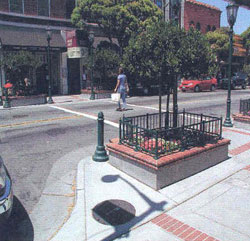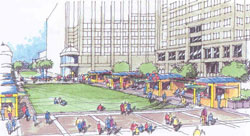Livable Streets Plan
Raleigh, North Carolina
Source: Pedestrian and Bicycle Information Center (PBIC)

A woman crosses at a midblock bulb-out.
Problem
The City of Raleigh needed an achievable action plan for the downtown that would support existing businesses, strengthen links with area neighborhoods, and provide a vision with clear goals.
Background
The Livable Streets downtown plan came to fruition through the broad-based Livable Streets Partnership, comprised of the Downtown Raleigh Alliance, the City of Raleigh, the State of North Carolina, Wake County, citizen and business interests, and public and private agencies. There were approximately 400 participants in all.
Solution
The group held openly public topic-centered work sessions to formulate goals and an action each month for a year. The City of Raleigh funded a study on streets, parking, wayfinding, and pedestrian needs that, among other diverse resources, were reviewed by partners and other participants as they explored new concepts for the downtown area. A final four-day charrette process sorted the plan into a series of approximately 130 Actions and Strategies. Five primary actions were identified to be accomplished in the following five years, one of which was to "improve the pedestrian environment."

The pedestrian-oriented objectives included to:
- Make downtown accessible to everyone
- Recognize the wellbeing of people on foot as a top priority
- Balance the needs of pedestrians against those of the car
- Create and attractive, well-lit, safe environment that links office and residential uses to amenities such as restaurants, museums, and other venues
Numerous recommendations were detailed in a Downtown Raleigh Pedestrian Design Toolkit (Matin/Alexiou/Bryson, PLLC in association with TooleDesign). Strategies included converting one-way streets to two-way operation with more space for bike lanes, sidewalks, or medians; installing street furniture; requiring pedestrian-oriented ground level uses with detailed facades; improving lighting; installing curb extensions, refuges and other measures to improve pedestrian comfort at mid-block crossing and intersections; providing a variety of seating areas near common gathering places; and more.
Funding and in-kind contributions came in part through a wide variety of sponsors including local and national financial institutions, real estate associates, energy corporations, and other business and nonprofit organizations. Costs for consultant work totaled $435,000.
Results
The planning process took just over a year before the plan was approved by the City Council in May of 2003. All top five priorities are in the process of being implemented. As of 2006, several streets already underwent redevelopment into two-way streets with significant improvements for pedestrian safety and comfort.
Contact
Downtown Raleigh Alliance
http://www.godowntownraleigh.com/
(919) 832-1231
Mitchell Silver, Director
City of Raleigh Planning Department
Mitchell.silver@ci.raleigh.nc.us
(919) 516-2626
Images Source
Institute of Transportation Engineers Pedestrian Project Award Application. City of Raleigh Planning Department.




